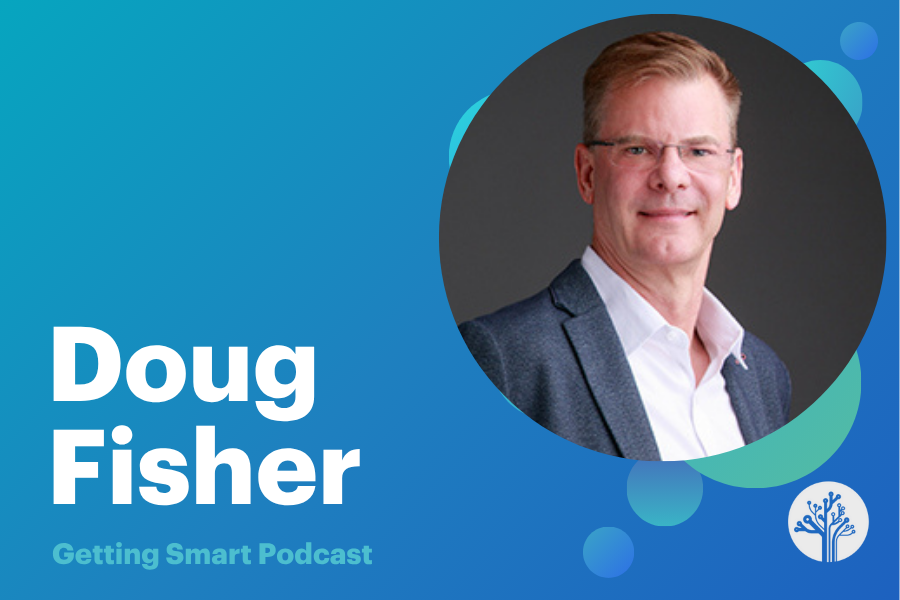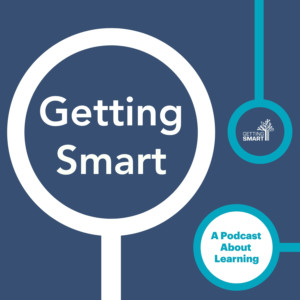Doug Fisher on AI Ethics and Responsibly
Key Points
-
It’s crucial to integrate teaching about AI into K-12 education to ensure students use AI ethically, responsibly, and effectively.
-
Schools must prioritize skills like dialogue with AI, data literacy, and curiosity to prepare students for a computational future.

In this episode of the Getting Smart Podcast, Tom Vander Ark sits down with Dr. Doug Fisher to discuss the new book, Teaching Students to Use AI Ethically and Responsibly. Together, they explore the critical need for AI literacy in schools and how educators can teach about, for, and with AI to prepare students for a computational future. Dr. Fisher emphasizes the importance of fostering curiosity, ethical decision-making, and data literacy while sharing practical examples of how schools can integrate AI into classrooms. This conversation is a must-listen for educators and leaders looking to embrace the opportunities and challenges of AI in education. Tune in to learn how we can empower future-ready students to navigate the world of AI responsibly.
Outline
- (00:00) Introduction: The Explosion of Knowledge and AI in Education
- (05:21) Collaborative Writing and the Book’s Framework
- (17:39) Teaching For AI: Essential Skills for Students
- (22:11) Teaching With AI: Practical Applications and Quests
- (28:17) Future of AI in Education: Simulations and Advice for Leaders
Introduction: The Explosion of Knowledge and AI in Education
Tom Vander Ark: We’re living through an explosion of knowledge. At least 4 billion people have access to expertise in ways that we never have before. And it’s calling into question: What is education for? How will we use this new technology in education? Fortunately, today we’ve got a thoughtful set of answers to at least some of those questions with Dr. Douglas Fisher. I’m Tom Vander Ark, and you’re listening to the Getting Smart Podcast. We’re exploring a new book called Teaching Students to Use AI Ethically and Responsibly. One of the co-authors is Doug Fisher. Doug has a wonderful and unique life. He is a professor at San Diego State and a teacher-leader at Health Sciences High School in San Diego. I super appreciate his leadership in both of those roles and his collaboration on this great new book. Doug, it’s great to have you on the show.
Doug Fisher: Thank you. Good to be here.
Tom Vander Ark: How do you pull that off—being a professor at San Diego State and a teacher-leader at Health Sciences?
Doug Fisher: Well, I think of this as my lab. You know, like if you’re a science professor and you have a lab, or if you’re a medical professor, you have a clinic. If you’re in psychology, you might still be seeing patients. I think having a lab where it’s real—not an artificial clinic or something like that—has really helped me. My colleagues, Nancy, Ian, and others, have really refined how we think about it. I do get some criticism that I don’t have a specific area of specialty because I’m interested in things as they happen in a real school. Being in a real school, being a leader in a real school, and helping teachers become their best selves in a real school has really influenced how I think about the world and how I make recommendations to people who listen or read. I want to make sure things actually have some validity, reliability, and trustworthiness before we put them out in the world. I love going to inspirational speeches, but I also want to know: How did this actually happen, and what was the impact of it?
Tom Vander Ark: Right. How’s it going to change how we teach biology to 10th graders? And what could they do with these new tools that they couldn’t do last year? Doug, I really appreciate Health Sciences High. As I noted before we started, I bring busloads of people to visit Health Sciences High as a great example of a pathway school—a focused pathway centered on health sciences careers. So, it is a terrific lab. This book, Teaching Students to Use AI Ethically and Responsibly, looks like a collaborative effort. Can you tell us about your co-authors and maybe the origin story that led to the book?
Doug Fisher: Sure. Sal Khan from Khan Academy is one of the leaders in technology and education. I appreciate his platform and his willingness to share resources widely with the world. We have used Khan Academy at our school for a really long time, so it was natural, as they started thinking about Conmigo and their platforms, to ask: How do we get good information out that has been tested—not theoretical, like “AI is coming, good or bad”? So, Khan Academy and Sal Khan were logical choices. Nancy Frey and I have collaborated for many years. We met in 1997 when she was a district coordinator in Florida. She moved to San Diego, and we’ve been friends and colleagues for a really long time. Then there’s Jim Marshall. His expertise is around program evaluation and determining impact. He does a lot of AI work at the higher ed level and in non-formal education settings like museum-based education. He was a zoo educator for a really long time, so he brings another perspective. Megan Hargrave has been doing a lot of work around the country on integrating AI into school systems. She’s really developed her teacher expertise—how we use this app for teachers. The logic is: Teachers are becoming increasingly comfortable, and they’re starting to have their students use AI. Well, I shouldn’t say it that way. The students are already using AI—they have been way before many of their teachers. However, using it in ethically responsible, trustworthy ways may not always be how students use AI. So, channeling the use of AI and showing students the good, bad, and ugly of AI was part of our motivation.
Tom Vander Ark: What are the pros and cons of writing with a group like this?
Collaborative Writing and the Book’s Framework
Doug Fisher: Ah, yeah. Different philosophical orientations, different writing styles, time zones—all of that is complicated. Some people prefer synchronous work, like being in a document together. Some people still use Word docs. So, there are just different styles. But the cool thing is, when you come together and have a framework and start to reach agreement, your thinking starts to expand. Your thinking gets revised and challenged. You have to decide: What can you put in one resource, and what needs to be in other resources? How do you define the boundaries or limits of what you’re going to include? How do you make it as accessible as possible for people to actually try? All of those conversations upfront set you up for success.
Tom Vander Ark: I’m going to say this three times in our podcast: I super appreciate your experience and approach to the work you’re doing and to this book. As sort of an armchair expert who hasn’t been a school administrator in 30 years, I deeply respect the work that you’re doing and the approach you took to this book. The outline is really simple and thoughtful. You talk about teaching about AI, teaching for AI, and teaching with AI. I’d love to spend three or four minutes unpacking each of those sections. Let’s start with teaching about AI. Is this computer science and AI literacy?
Doug Fisher: Yes, and AI fluency. We take kind of an “under the hood” mindset here. I guess I’ll say this: You don’t have to know everything about a car’s engine to drive a car, so we’re not going to that depth with our students. You don’t need to know every aspect of a car’s engine. However, you do need to know some things, like how to turn on your signal or your windshield wipers. There are things you have to know about how it works. That’s the perspective we have: Students need to understand some very basics about how AI functions. They have to understand some of the structures, the way data is taken, and what training data is. We want them to understand what they’re talking about. When we first started this journey a couple of years ago, our students thought AI was smart. They thought AI was a person on the other side responding to them. When we look back to our first foray into this with students, they personified it. They believed it was right. So, we had to help them understand what we’re talking about here. Then, of course, all of us—students included—are seeing all these movies in which AI is completely vilified, ruining humans and taking over the world. That’s why we have the “about AI” section. If I could go back to my motivation, I’ll say something else. I believe we, as a profession in education, missed the mark on social media. It came on board, spread widely, and we virtually did nothing. We let it happen and were passive about it. I believe we’re paying the price today for that.
Tom Vander Ark: Totally. Doug, let me pile on. I’m guilty on this front. When the iPhone came out and when social media exploded, I was a tech optimist. I really thought social media would level us up to a common good, a common truth—that it would build community in that way. And it’s done just the opposite. It’s forced us into our own information gullies. It’s made us dumb and mean. I’m just super—it’s made me cautious about unintended consequences. I think it’s an important parallel.
Doug Fisher: Thank you. I don’t want to miss the opportunity this time. That was my original motivation. I honestly believe we, as educators, missed the opportunity to teach young people ethical and responsible use of social media. The genie’s out of the bottle; it’s too late. Now we have a new genie, and it’s out of the bottle. We have to decide: Are we stepping up as educators and helping children and youth understand the power and potential of this, as well as the risks? That’s why we have the “under the hood” section. We believe there are some basic things that students should know and understand about AI.
Tom Vander Ark: On this subject of teaching about AI, are there any shoutouts you want to make about people or groups that you think are doing a reasonable job? Do you appreciate the work of the TeachAI Coalition?
Doug Fisher: Yes.
Tom Vander Ark: Who else do you want to mention?
Doug Fisher: The North Carolina Department of Public Instruction has just put out some very thoughtful pieces that we are using in our school. They were the first group we ever saw that argued for leveling assignments on AI use. We’ve modified it, but the idea came from them. They suggested having a way to say, “This assignment task or activity is zero AI, consultative AI, or full use.” We adopted that early on. Luckily, we did because we were very transparent with our students about what we expect with AI. It has served us well. As a school, we are not having conversations about kids going behind our backs and “cheating” with AI because we’re very transparent about what it means and when they can use it. Do students sometimes violate the rules we set for an assignment? Yes, but that’s a different conversation because they knew going into it what was allowable and not allowable. Unfortunately, a lot of schools haven’t taken what North Carolina put out there and socialized it in their own organization. They haven’t taught young people, “This is the rule for this assignment. Here’s why I want it to be a level one, a level four, or a zero.”
Tom Vander Ark: I want to mention a couple of other folks: AI for Education, AI EDU. We’ve also worked with CSTA, the Computer Science Teachers Association, and in California, the Cal MSCS. It’s a great example of county offices helping to thoughtfully infuse K-12 computer science principles into teaching. This took a while to emerge. It’s been late, but the response on this subject of teaching about AI is beginning to emerge. Schools have lots of choices, many of them free and openly available. Thank you for starting there. What is teaching for AI?
Teaching For AI: Essential Skills for Students
Doug Fisher: That’s where this all started. The original impetus for this, which expanded naturally as projects evolve, was: What skills do we need to develop in young people so they can effectively, efficiently, responsibly, and ethically use AI? We did a scan. We used crowdsourcing, literature reviews, and tests at our own schools and in our communities. What are the skills that young people need? Some of these skills are repurposed from the past, and some are new. We’ve argued through this process that if you don’t understand dialogue as it applies to AI, you are going to be left behind. Dialogue has been around with humans for a really long time, but AI dialogue is unique in its perspective and the way in which we interact with it. Curiosity is super important. We’ve tried to teach curiosity for a really long time. It’s partly why I work at a pathway school—I want to foster that curiosity. But curiosity with AI is something we really want to maintain because some young people think one answer is it. They don’t have that interaction, curiosity, or exploration.
Tom Vander Ark: I’m smiling because I’m wrapping up a blog on curiosity right now and arguing that it warrants a modern emphasis. It’s always been important, but in the age of AI, it is critical. Humans are curious; computers are not. I heard an author say that this morning. I appreciate your focus there.
Doug Fisher: Then there are some more specific skills that are emerging. Prompt engineering is one of them. I don’t know how long that will last. Right now, it’s super important. I wonder if, in the future, we’ll still think about prompt engineering. So, that’s one skill that might be temporary, but it’s important right now.
Tom Vander Ark: Broadly speaking, it’s about opportunity recognition. It’s about question formulation, problem finding, and articulating a strategic intent. It’s married with critical thinking.
Doug Fisher: Yes.
Tom Vander Ark: I think it will be important for as far as we can see. There was a lot of frothy optimism about vibe coding and generative AI. I listened to three podcasts this morning that said curiosity and agency, paired with critical thinking, will create the intent that launches agentic work. These will be important for a long time.
Doug Fisher: I am happy to hear that. I also listen a lot on these topics. On our general AI systems, you really have to know more. But as we get more specialized systems and they start to constrain, you’re seeing less demand on prompt engineering. So, that skill might evolve.
Tom Vander Ark: I mean, it’s already shifted from engineering to context engineering.
Doug Fisher: Yes.
Tom Vander Ark: But the point is, it’s still about driving a set of inputs—identifying problems that are worth attacking and being really thoughtful about how you do them. I would pair it with curation. My blog is pairing curiosity and curation. Curation is on the backside. Now that we have tools doing more of the work for us, curation—the judgment, application, checking of the work, selecting the good, and iterating—is critically important. That combination of curiosity and curation is now more important than ever. Yes, they’re going to evolve in how we express them, but I think for as far as we can see, those will remain important.
Doug Fisher: I think that’s going to be the case. I cannot predict the future, but we can make informed guesses about where the world is going. That’s going to be one to watch. We’re also watching how prompt engineering changes. Data literacy is another skill we have to develop stronger.
Tom Vander Ark: And on this subject, every field has become computational, right? If you want to be a biologist, a scientist of any sort, an accountant, or a lawyer, every field is now computational. In every field, you now need to be a data scientist. You need to be thoughtful about the data sets you’re using to query problems that are relevant to you and the world.
Doug Fisher: I’ll go back to our school, Health Sciences High. This year, we hired a data scientist. It’s a part-time position right now. This data scientist has an agreement—a formalized agreement—to have access to all of our data systems to query and generate reports for the senior leadership team. Our data systems in schools don’t really talk to each other. If you’re a superintendent or a principal, you have to go out, find the data, and look for the relationships. I believe we need data scientists. They need to report to the highest level and not be filtered through human resources or curriculum and instruction. They need to report to high levels and have fairly unfettered access to data—with confidentiality agreements and trust—so that we get really good information as leaders to make informed decisions. I need to know what the data means, how to find it myself, and how to verify it. But I run out of time. By having this part-time person with this contract, I’m getting reports of information I never had before—some of which I didn’t think about and some of which I just haven’t had time to do. I think every one of us should become increasingly data literate and figure out the data we need to make the best decisions for our organization.
Tom Vander Ark: I love that, Doug. I want to give a quick shoutout to Prep KC, a great organization in Kansas City that, for six urban districts, is inviting eighth graders into a data science course where they do community-connected projects. It’s a terrific example, even in the middle grades, of inviting students into AI literacy, data literacy, and applying it in experiential learning. On the subject of teaching for AI, I’ve come to a renewed appreciation for deeper learning—for Michael Fullan, for High Tech High, and for the High Tech High Graduate School of Education. These champions of deeper learning advocate for the six Cs: creativity, critical thinking, communication, and often interdisciplinary, project-based learning. You touch on that in the book. Do you buy that connection—that deeper learning is now more important than ever?
Doug Fisher: Absolutely. We use the framework of surface, deep, and transfer learning. Deep learning is a goal. Transfer of learning is an elusive goal in our profession. Quite frankly, the little dirty secret in education is that we very rarely teach to transfer. Most of what we teach doesn’t actually get to transfer. However, all of that is foundational in surface learning. We have to build surface learning with students. I think we’re spending too much time on surface learning, but you can’t go deep if you didn’t start at the surface. I had an assistant superintendent say to me a couple of years ago, “I want our students swimming in the deep end of learning.” I said, “They will drown without sufficient surface learning.” I do want deep learning. I want transfer of learning. But I also want to recognize that there are foundational elements. The problem with the term “surface learning” is that it sounds superficial. The reality is, we need to go from surface to deep to transfer.
Tom Vander Ark: Thank you for that, Doug. That’s super important. A minute ago, we were talking about context and context engineering and how important that is. Transfer is using a core set of durable skills across multiple contexts. I think you’ve expressed well the new goal of teaching for AI. All right, what about teaching with AI? What do you think that looks like?
Shorts Content
Teaching With AI: Practical Applications and Quests
Doug Fisher: We took a fairly simple approach. There could be many more books on teaching with AI. What we decided was to create some quests—short quests—where we could show teachers, especially those who are cautious about it, some intentional ways to use AI. These are intentional ways to invite students into the world of AI. So, we framed these quests. You probably recognize this: Bernie Dodge was a professor at San Diego State. He’s one of the teachers who influenced me early in my career when I took his class long ago. He built WebQuests, which constrained students’ use of the World Wide Web. I believe that was really helpful in constraining students when they searched the web when it was new and we were concerned. Out of respect for Bernie Dodge’s WebQuests, we took on this idea of the next generation of quests. That’s where it came from.
Tom Vander Ark: I love that framing. What about tutoring? Everybody’s talking about tutoring post-pandemic. A lot of people are bullish on tutoring. Tech enthusiasts say we’re all going to have an AI mentor talking to our lapel mic all day long. Where do you come down on tutoring?
Doug Fisher: We do use some intelligent tutoring systems here at our school, and there is a section on intelligent tutoring in the book. To me, the ones we have access to are not sophisticated enough to keep the students engaged. So, we still have adults involved. They might use the systems—like Conmigo, for example—but we also have adults there. When students get frustrated, you have to have a certain level of literacy to use the AI tutors in the first place. I want to recognize that there is still a remaining value in literacy to engage in these systems. We are using them and testing them. I believe they’re going to become increasingly sophisticated over time. Right now, there is a human touch, especially with our most reluctant learners. They don’t feel successful in many things. When they develop that relational trust with an adult, we can use the systems we have to support their learning.
Tom Vander Ark: Doug, I want to jump on my hobby horse for a minute and talk about math. What frustrates me about this current stage of teaching with AI is that everybody working on math is, I think, automating bad pedagogy. We continue to use smart tools to teach hand calculations. I listened to a podcast yesterday with a guy who could score worksheets of kids doing hand calculations. I’ve come to think, like Conrad Wolfram, that we should teach math as if computers existed. Suddenly, long division, factoring polynomials, and other hand calculations are far less relevant. Most of what’s happening in AI today is using it to automate the teaching and scoring of skills that are no longer relevant. Do you buy any of that?
Doug Fisher: I do buy that. Let me give you an example. We did a video this summer in a personal finance class in our pathway. The students had been learning about budgeting. The teacher used AI to generate 35 different scenarios, which was great because, in the past, the teacher would never make individual scenarios for the entire class. It would be mind-blowing. Every kid had one, and they had to use AI to negotiate: What do I need? What is AI telling me about this person’s budget? Then they had to make decisions and do case studies. This whole lesson here’s the feedback I got: “Students have to learn how to use spreadsheets.” This feedback didn’t come from the teacher or the kids but from someone who watched the video and wrote to me. They said, “That teacher’s not teaching them how to use Excel spreadsheets.” I was a little mind-blown. First of all, we don’t know if the teacher did that or not from the video. Second of all, is that a useful skill in the future—to build your own spreadsheet?
Tom Vander Ark: Well, that’s a good question. Do you actually have to know the formula for net present value in a spreadsheet? Yes, you still have to know how to use spreadsheets, I would argue, alongside a smart assistant. But that’s a great example. I think we’re having this debate now. We’re certainly having it in writing.
Doug Fisher: Oh yeah.
Tom Vander Ark: Should students learn to write by hand first? Should they learn to write long-form digital without an AI assistant and then with one? I think in every area of creation and expression, we’re having this debate. It’s live. Well, what about simulations, augmented reality, and XR? What’s your take on those in terms of teaching with AI?
Future of AI in Education: Simulations and Advice for Leaders
Doug Fisher: We headed down the augmented and virtual reality path. We made a whole bunch of simulations, mostly for teachers. We did some with students. But we’ve put all of that on hold right now. AI is more powerful than that. We really headed down that path—we had a VR lab, goggles, and all this stuff. We were doing some teacher work on this, like, “Here’s a classroom. What would you do next?” But for me, in our work at the university and at school, that’s all on hold. We’re really exploring more with AI. In fact, I’m more interested in simulations using AI than augmented or virtual reality.
Tom Vander Ark: I agree. There are exciting things happening in career simulations and AI. We’re talking to Dr. Douglas Fisher, professor at San Diego State and teacher-leader at Health Sciences High in San Diego, one of our favorite schools. Doug and colleagues are authors of the terrific new book Teaching Students to Use AI Ethically and Responsibly. We just walked through the framework: teaching about AI, teaching for AI, and teaching with AI. Doug, it’s a great framework. It’s simple and thoughtful. I appreciate all the examples in the book. I think it’s an important contribution.
Doug Fisher: Thank you. Thank you very much.
Tom Vander Ark: Any words of advice for the education leaders who are listening or watching? If you’re a school leader, what’s one or two things you’d love to see them do this year?
Doug Fisher: Well, I’ll say this: Don’t leave out your K-2 teachers. In every one of those sections of the book, we talk about the implications for the primary grades—the skills, the learning about, and the learning with. I think a lot of conversations frame this as a high school thing, but the reality is those skills take a long time to develop. Some of the time, those kids already have tremendous curiosity, and we teach it out of them. I don’t want to leave out the K-2 teachers in this conversation about AI. They often say it’s not relevant for them. It is 100% relevant. I also think we have an ethical responsibility to teach responsible, ethical use of AI. Let’s not repeat the social media mistake we made—unintended though it was.
Tom Vander Ark: Doug Fisher, author of Teaching Students to Use AI Ethically and Responsibly, thank you for being with us.
Doug Fisher: I enjoyed it. Thanks for the conversation.
Tom Vander Ark: Thanks to our producer, Mason Pasha, and the whole Getting Smart team. Until next week, keep learning, keep leading, and keep innovating with AI.
Guest Bio
Douglas Fisher
Douglas Fisher is professor and chair of educational leadership at San Diego State University and a teacher leader at Health Sciences High and Middle College. Previously, Doug was an early intervention teacher and elementary school educator. He is a credentialed English teacher and administrator in California. In 2022, he was inducted into the Reading Hall of Fame by the Literacy Research Association. He has published numerous articles on reading and literacy, leadership, and curriculum design, as well as books such as The Teacher Clarity Playbook (2nd ed.), Your Introduction to PLC+, The Illustrated Guide to Teacher Credibility, Instructional Strategies to Move Learning Forward: 50+ Tools That Support Gradual Release of Responsibility, and Welcome to Teaching!
Links










0 Comments
Leave a Comment
Your email address will not be published. All fields are required.